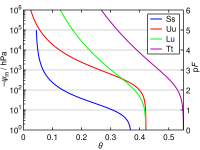Water retention curve

Imagine you have a big bucket of sand. You pour water onto the sand, and at first, the sand takes up the water quickly. But as you keep pouring water in, at some point, the sand can't soak up any more water. That's because the sand can only hold so much water before it gets too squished.
Now imagine instead of sand, you have soil. It's the same idea: soil can only hold so much water before it gets full. The water retention curve helps us understand how much water soil can hold at different levels of "squishiness."
At the top of the curve, the soil isn't very squished at all, so it can hold a lot of water. But as you go down the curve, the soil gets squished more and more, so it can't hold as much water.
Scientists use the water retention curve to figure out how much water different types of soil can hold, and how fast water can flow through that soil. This is important for things like farming, where you need to know how much water your plants are getting, or for figuring out how water flows through the ground during a flood.
So basically, the water retention curve helps us understand how much water soil can hold at different levels of squishiness, which is important for lots of different kinds of science.
Now imagine instead of sand, you have soil. It's the same idea: soil can only hold so much water before it gets full. The water retention curve helps us understand how much water soil can hold at different levels of "squishiness."
At the top of the curve, the soil isn't very squished at all, so it can hold a lot of water. But as you go down the curve, the soil gets squished more and more, so it can't hold as much water.
Scientists use the water retention curve to figure out how much water different types of soil can hold, and how fast water can flow through that soil. This is important for things like farming, where you need to know how much water your plants are getting, or for figuring out how water flows through the ground during a flood.
So basically, the water retention curve helps us understand how much water soil can hold at different levels of squishiness, which is important for lots of different kinds of science.
Related topics others have asked about:
